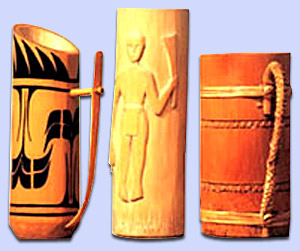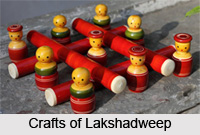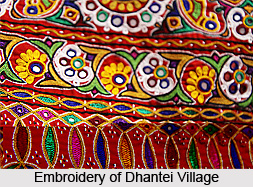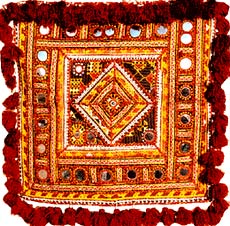 Embroidery Work in India is carried out in Punjab, Uttar Pradesh, West Bengal and many other regions. Buttonhole or Blanket Stitch, Running Stitch, Cross Stitch, Satin Stitch and Chain Stitch are some of basic techniques of stitching used in Indian Embroidery. It has also given way to machine stitching with the advent of the industrial era. There are diverse varieties of Indian embroidery.
Embroidery Work in India is carried out in Punjab, Uttar Pradesh, West Bengal and many other regions. Buttonhole or Blanket Stitch, Running Stitch, Cross Stitch, Satin Stitch and Chain Stitch are some of basic techniques of stitching used in Indian Embroidery. It has also given way to machine stitching with the advent of the industrial era. There are diverse varieties of Indian embroidery.
Influenced by a variety of cultures, India has downed during numerous invasions and settlements and Indian embroidery from all regions has an essence of its own.
History of Embroidery in India
Themes and designs have stayed as such for centuries. In the pre-historic civilization, it was the same embroidery needles which have been found in excavations. The patterns have always been floral, animals, geometric and religious. Each embroidery style has its own history and a story of expansion. Indian embroidery receives its inspiration from nature and religion. The colours, the bottom, the subject matter and the fashion, all are reflective of a particular area. Embroidery on leather, velvet, net, cotton and silk are through all over the country. The patterns are decided upon on the base of the fabric and its quality with the stitches depends upon the style and the produce to be created.
Materials for Indian Embroidery
The materials used in Indian embroidery like the fabrics and yarns vary from one place to another. Silk, wool and linen are predominantly used for thousands of years for both fabric and yarn. In the recent times, the thread used in traditional embroidery is manufactured in rayon, cotton, as well as traditional wool, silk and linen. In the techniques of canvas work, huge quantities of thread are buried on the back of the work to use more materials but provide a sturdier and more substantial finished textile. Further, in surface as well as canvas work techniques, an embroidery frame is generally used for stretching the material as it ensures that any sort of pattern distortion.
Famous Indian Embroidery
Designs in Indian embroidery are shaped on the base of the surface and the design of the material and the stitch. The dot and the swap dot, the circle, the square, the triangle and permutations and combinations of these form the design. The famous Indian embroideries are as follows:
Aari: Aari work contains a hook, plied from the top but fed by silk fibre under with the fabric spread out on a frame.
Chikankari: Chikankari is a fine and elaborate stitching style which is believed to have been introduced by Nur Jehan, the wife of Mughal ruler Jahangir. A chikan piece is created by block printing patterns on it. Craftsmen then stitch sew along the pattern and the finished piece is later washed to eradicate traces of the prints.
Banjara Embroidery: Banjara embroidery is a mix up of mirrors and beadwork. Bright red, yellow, black and white coloured cloth is laid in bands and joined with a white criss-cross stitch.
Banni or Heer Bharat: The Banni or Heer Bharat embroidery creates in Gujarat and is exercised mostly by the Lohana area. It is done with silk floss and it is famous for its liveliness and richness in colour pallets & design patterns.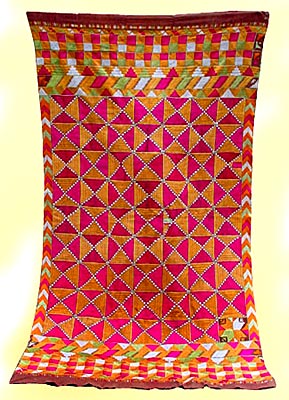
Kantha: Kantha work is recognized for its simplicity. Kantha was done on flexible dhotis and sarees, with an easy running stitch along the edges.
Phulkari: Phulkari is the embroidery of flower motifs on textile. Usually practised by women of the house as an amusement, this embroidery is pretty a unique one. The stitches are embroidered on the reverse of the cloth so that the design takes shape in the front.
Chamba Rumal: This embroidery increased in the generous hill states of Kangra, Chamba, Basholi, and other nearest provinces.
Gota: It is a shape of applique in golden thread, used for women"s ceremonial attire.
Karchobi: It is raised zari metallic thread stitching created by sewing flat stitches on cotton lagging. This technique is usually used for bridal and formal costumes as well as for velvet coverings, tent hangings, curtains and the coverings of animal carts and temple chariots.
Zardozi: Original Zardozi work used gold and silver threads as well as pearls and expensive stones and the choice of fabrics too had to be majestic. Zardozi work uses a mixture of copper wire with silver or golden polish and silk threads.
Kashidakari: Kashidakari draws a lot from the flora of the state. However, human and animal figures are not a part of this style of embroidery. An exclusive feature of Kashidakari is the Kashmiri tea pot.
Kashmiri Kashida: Kashmiri embroidery, also known as Kashida is used for phirans and namdahs as well as stoles. It draws encouragement from nature. Birds, blossoms and flowers, creepers, chinar leaves, ghobi, mangoes, lotus, and trees are the most common themes.
Pichwai: Multi-coloured embroidered cloth-hangings made in Nathdwara, Rajasthan. The central themes for Pichwai were focused on Lord Krishna.
Rabari: This very bright embroidery style, by the severe contrast was traditionally used only for garments, but now it can be found on bags, accessories, home furnishings, etc. Mirrors of all shapes and sizes are included in the embroidery, as an effect of the belief that mirrors protect from evil spirits.
Toda: The stitching adorns the shawls. The shawl, called poothkuli, has red and black bands between which the stitching is done.
Applique work is seen in Odisha and Gujarat. It is basically a patch work in which coloured pieces are cut and sewn on a plain cloth. Embroidery of Kutch is known as Aribharat is very attractive. Embroidery of Lambada tribes of Andhra Pradesh is worth mentioning here. It is done on fine cotton or polyester. Kantha stitch is practiced in Bihar and West Bengal. Here the threads are picked from old materials.



